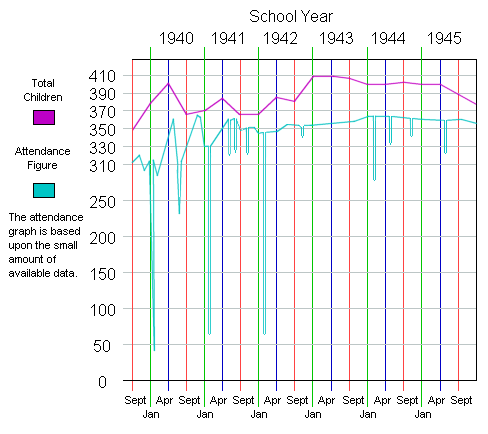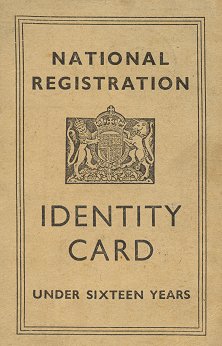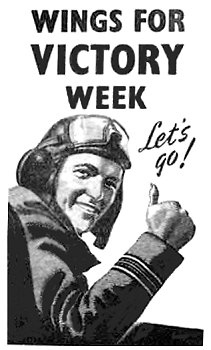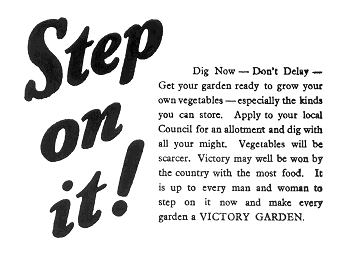Britain and France declared war against Nazi
Germany on Sunday, 3rd
September, 1939, the day before the start of the school
year. During the war many changes would take place at
the school due to wartime regulations and the necessity
to take part in the war effort.
On the morning of Monday, 4th September
about 100 children and the school staff assembled in the
hall. The children were told that for one week, or until
further notice, the school would be closed, and they
were sent home. A rota of
staff was duly organised and during the next few weeks
two members of staff attended the school daily. On
Saturday, 29th September a meeting of head
teachers was held in Wolverhampton and they were
instructed to open their schools as usual as from the
following Monday.
During September the staff undertook A.R.P. (air raid
precautions) duties, attended a course on dealing with
incendiary bombs, and carried out clerical work in
connection with the National Register (identity cards
were issued to all civilians recorded on the National
Register, from 1939 to 1952), and National Food Control
(food rationing books were introduced in October to
ensure the fair distribution of food, due to shortages).
Mr. Thacker also had to attend meetings about fire
prevention, and blackout curtains would have been fitted
to comply with the blackout regulations.
|
|

Ration coupons from a ration book. |
On the first morning back about 80 juniors attended
morning assembly. They were instructed to go home and
inform absentees that school would re-open for juniors
only, the next day. On Tuesday 162 children out of 225
were present. The infants returned on October 16th,
bringing the total number of children attending the
school to 360. In 1939 British
health departments were giving mothers and infants free
milk, cod liver oil and vitamins. Many children at the
time were
undernourished and it was felt that free milk
would improve general health and increase weight. Each
infant would receive a free ⅓ of a pint bottle of milk
at school every morning. This was taken very seriously
and the infants were periodically required to attend a
clinic to be weighed.
|
| In November a jumble sale was held to raise funds
for a Christmas party.
The party took place in the
school hall on 22nd December, the last day of
term. Each child received a parcel containing biscuits,
chocolate, toffee, an orange, apples, and novelties. The
apples were kindly provided by
Councillor F.C. Wesson. |
| In January 1940 attendance figures fell to 287 due
to illness and the extremely cold and severe weather.
During the last week of the month heavy snowfalls and a
lack of heating fuel led to the children being sent home
early on several occasions. On Monday the 29th
only 39 children were present. The situation continued
to deteriorate and by the 5th
February it became almost impossible to remain at
school. As a result the school closed for the remainder
of the week. School attendances would often fall
because of bad weather. Winters at the time were more
severe than today. On the 20th and 21st
January, 1941 a heavy snowfall resulted in a total
attendance of only 77 children. Exactly one year to the
day later another severe snowstorm resulted in only 74
children attending, which was repeated three days later
on the 23rd. Other poor attendances were
caused by heavy rain, thick fog, and colds. |

A clothing ration book. |

School attendances during the war years.
|

Clothing coupons from a clothing
ration book. |
Throughout the war the school nurse
continued her visits to inspect the children. Her visit
in September 1940 resulted in 43 children being listed
as having problems with their cleanliness. From then on
they were monitored and the situation soon improved.
Also during the year two members of staff, Mr. Frederick
Hudson, and Mr. Leslie Dunn left to do military service.
|
| A once familiar sight
along the southern boundary of the “Wake Field” (now the
school playing fields) were the school’s air raid
shelters. They were built of brick and concrete
with a covering of earth, as
part of a national government scheme. The school
received the keys to the shelters on 12th
April.
When air raid sirens sounded the children would march
into the shelters in orderly fashion and sit on the long
wooden benches along the sides. The shelters were dark,
damp places and so could be very unpleasant.
The only form of lighting came from torches carried
by the staff. On at least one occasion the batteries
were flat and so little light was available. The
children would often have a sing song with ears
carefully listening for the all clear. |

A child's identity card. |

An impression of how the school air raid
shelters looked without the perimeter fence.
|
Head teacher, Mr. Thacker organised
air raid drills in which he blew three short blasts on
his whistle as a signal for the school to empty. Each
class would then march into the shelters and stay there
until he blew an “all clear” signal.
Luckily for such a large industrial
area, and obvious target, Darlaston and the surrounding
areas suffered comparatively little damage from the many
German bombers that came across the channel. At the
time, the Government passed legislation to control
people’s
behaviour when using shelters. If anyone was
found guilty of wilfully disturbing other persons in the
proper use of an air raid shelter, he or she could be
sent to prison. |
|

A child's gas mask. |
The Government believed that some form of poison gas
attack would be inevitable and so gas masks were issued
to everyone living in Britain. By 1940 about 38 million
had been issued. Adults’ masks were black, and
children’s masks were in bright colours of red, blue, or
green, with bright eye-rims. They became known as
“Mickey Mouse” masks, to make them less frightening and
more appealing.
Each mask came in a strong cardboard box with a long
string handle, which children would use, to carry them
over their shoulder. People were expected to carry them
everywhere, but in practice few did. Air raid wardens
would carry out monthly inspections and anyone who lost
their mask would be required to pay for a replacement.
The school hall was used for the purpose of
distributing gas masks to the local population. They
were also available for young babies in the form of a
respirator, which totally enclosed the child. They came
complete with an air filter and hand-operated air pump. |
|
When the school children had been
issued with gas masks, gas mask drills were carried out
by Mr. Thacker and they were expected to carry their
masks during air raid warnings. The first air raid
occurred during the night of the 19th August
and on the following day attendances at the school fell
to 232. There were several long air raids during the
following weekend with children spending around 7 hours
each night in their families’ shelter.
The school’s shelters were used in
anger for the first time on 27th August when
an air raid warning sounded at 1-45p.m. with the all
clear at 2.05p.m. Over the next few months this would
become a regular event. Air raid warnings occurred on
the 5th and 11th
of September, the 15th, 17th, 28th,
and 30th of October. On the 31st
October the children were in the shelters for the whole
of the afternoon. Further warnings occurred on the 15th,
26th, and 28th of November. The
school suffered some slight damage on the night of the
28th when the roof and several windows were
damaged by anti aircraft shells.
The air raid warnings continued in
December with one during the afternoon of the 3rd,
four during the 4th, and two during the 12th.
1940 was the worst year for such events, but more were
to follow. There were two warnings in January 1941, and
another at the end of April. There were none in 1942 and
one last warning on 4th March, 1943. At this
time occasional air raid drills continued, but luckily
the shelters saw no further use. Originally they were
surrounded by a wooden fence, but on 7th
April, 1943 a fierce gale blew much of the fence down,
and injured one of the children, who suffered a broken
leg when part of the fence fell onto him. The fence was
duly repaired, but in May 1944 it fell victim to one of
the pupils. He lived in nearby Foundry Street and on a
single day he demolished much of it with an axe. After
the war the air raid shelters remained derelict for many
years, finally being demolished at the end of December
1964 and in early January 1965.
There were several other air raids
at night and on each occasion school attendances would
fall the next day. The worst local air raid occurred on
Thursday, 5th June, 1941 when a bomb, aimed
at Rubery Owen’s works, fell short of its target and
badly damaged several houses in Rough Hay, killing 11
people. As a result two children from Rough Hay were
admitted to the school on 20th June.
The school continued to actively
encourage saving as part of the National Savings scheme,
and the school’s log book records the sums collected. On
1st September, 1941, the first day of the
autumn term, a total of £31.16s.0d was paid in, which
was quite a lot of money at the time. The savings scheme
was clearly a success, as can be seen in June 1943 when
the school savings totalled £1,628.12s.10d. (well over
the £1,000 target). In June 1944 the savings
totalled £1,590 and in October 1945 the savings
reached £951.14s.6d. |
| During the war years the saving schemes were
extended to support the war effort. The War Savings
campaign was initiated by the War Office in 1939 and
Regional Savings Schemes began. Savers could purchase
certificates and bonds, and local collections were
organised to raise money for aeroplanes, tanks, and
other much needed items for the war. Events such as
“Spitfire Week” were organised to raise the much needed
cash, and schools savings groups were set up. Rewards
were given to the best fund raisers, as an incentive. In
July 1943 half a day’s extra holiday was granted by the
school managers in recognition of the school’s effort in
“Wings for Victory Week”. Collections were also made for
“Warship Week”, the Red Cross, the Staffordshire blind,
and the Local Comfort Fund. In April 1945 £10 worth of
comforts and delicacies were given by the school to
wounded and sick prisoners of war, who had recently
returned to England. “Salute the Soldiers Week” took
place in June 1944. During the week, wounded soldiers
came to the school and talked to the juniors about their
experiences. |
 |
|
Other wartime activities took place
during the long summer holiday. There were fire watching
arrangements to be made, and in 1942 the children had
the opportunity to attend voluntary and varied daily
activities, supervised by 3 or 4 members of staff. The
average attendance was about 40.
Even though things were in short
supply, the annual Christmas party took place, and was
usually funded by money raised at the Harvest Festival,
often from a jumble sale, or sale of fruit and
vegetables. In December 1940 each child received a
present consisting of a biscuit, and a book or jigsaw
puzzle. In 1943 the children were given tea, provided by
the parents, and proceeds from the sale of fruit and
vegetables. There were jam sandwiches, cakes, buns, and
jam tarts. The following day each child was given a
threepenny bit (a three pence coin). In the following
January the parents were invited to a school concert
given in recognition of their help with the Christmas
catering. The proceeds from another sale of fruit and
vegetables in 1943 amounted to £13.8s.0d. which went to
the Merchant Navy’s Comfort Fund and Birmingham
Children’s Hospital. A similar sale in 1944 raised
£13.11s.8d. for the Waifs and Strays Appeal and the
children’s Christmas tea. The Harvest Festival on 29th
September, 1944 raised £12 for the Darlaston Comfort
Fund. |
|

One of the many "Dig for Victory"
posters. |
The early years of the war are often remembered for
the “Dig for Victory” campaign in which people were
encouraged to grow their own fruit and vegetables to
offset the shortages in the shops. The school played its
own part in the scheme by encouraging the children to
take part in cultivating the strip of land that lies
along the front of the building. One wartime event
which most participants may remember, took place on 26th
February, 1941 when the whole school went to Station
Street to greet the King and Queen on their visit to the
town. |
|
One important change at the school
during 1943 was the introduction of school dinners. This
took place a whole year before the Government made it a
Statutory requirement to provide school meals, in the
1944 Education Act. On 29th June crockery and cutlery
for the meals arrived at the school and the first school
meals staff commenced duty on 1st July. They were Mrs.
M. Bartram, Mrs. E. Burgess, and Mrs. K. Turner. The
first school dinners were served in the hall on 5th July
to 97 children and 4 teachers. The school meals staff
were ably assisted by school caretaker, Mr. A. Bartram,
who arranged the tables and chairs, and helped with the
fetching and carrying.
Another important event took place
as part of the 1944 Education Act; the introduction of
the Eleven Plus examination. This allocated pupils to a
suitable secondary school which was best suited for
their abilities and aptitudes. Three types of secondary
schools were available. They were grammar schools,
secondary technical schools, and secondary modern
schools. The Act also allowed for the creation of
comprehensive schools, and created a system of direct
grant schools, under which a number of independent
schools received a grant from the Ministry of Education
for accepting a number of none fee paying pupils.
Towards the end of the war, on 12th
December, 1944 a police officer gave a talk to all of
the children about “booby traps” and grenades, and in
December all juniors sat an examination, but severe
paper shortages meant that examination reports could not
be sent to their parents. It was all over in 1945. VE
Day (Victory in Europe) was held on 8th May,
and VJ Day (Victory in Japan) took place on 15th
August. The school celebrated the end of the war with a
fancy dress party and a victory tea on the 26th
October, and on 9th November a special
remembrance service for Armistice Day was held in the
hall.
During the war there had been a
shortage of teachers and as a result the school acquired
two well liked and respected members of staff. Mr.
William Martin Scarth was transferred from Rugeley C. of
E. Junior Boys School, and started at Pinfold Street on
8th January, 1945. Mrs. Gwendolen Hill was
transferred from Addenbrooke Street School and started
at Pinfold Street on 14th February, 1944.
|
 |
|
 |
|
 |
Return to
A New School |
|
Return to the
beginning |
|
Proceed to
Post War Years |
|